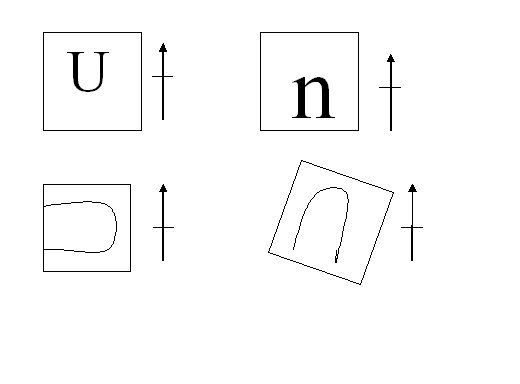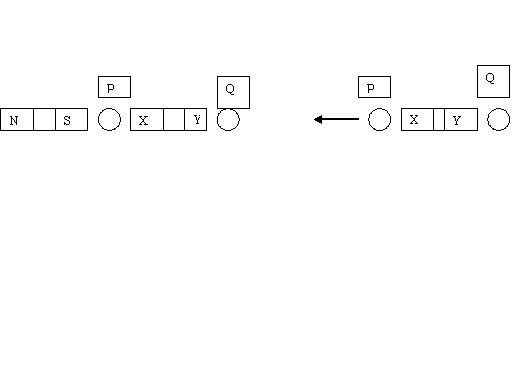Physics - Magnetism
-
Just finished a set of papers and I have got some questions (a number of them in fact) which I am unsure of. Please do check if I got the answers right or wrong and explain to me the concepts behind them if I did them incorrectly.
1. A permanent magnet hangs freely from a cotton thread. In which compass direction does the N-pole of the magnet point?
I wrote the "North of the compass". But my bro says it is the opposite because the earth's south would attract the magnet's north. I think it's wrong. I looked at diagrams in my notes and all the compass points north correspond to the magnet's north.
2. Making a bar magnet: a metal bar is placed inside solenoid and current is switched on. With the current in the coil, the metal bar is slowly withdrawn. Explain whether metal bar is still a magnet when out of the coil.
My answer: No. As we remove metal bar from solenoid, the south pole of bar (towards right side is the S-pole) would become N-pole because current is still flowing and following corkscrew's rule, I managed to determine left side is N-pole. So as S-pole moves towards N-pole, it also loses its magnetism. Thus, bar is no longer magnet. (something like that, I think)
3. Just to check, energy changes from electric bell are as follows:
chemical energy -> electrical energy -> magnetic energy -> kinetic energy -> sound energy
4. A metal bar P-Q hung by a thin thread alwats comes to rest with end P pointing North. Another bar X-Y of the same metal settles in no definite direction. What happens when metal bar P-Q is brought closer to the other bar?
I wrote End P neither attract nor repel end X. I do not know the rationale behind this really. Or is it end P and end Q BOTH attract end X?
Some more questions to come (needa draw them in diagrams). Thank you. (you may answer questions you are confident of only)
-
answer:
magnesium energy = power
so,take power + P so kinetic energy is also known as technology
divide electrical energy.and you get the answer.
chemical energy is 125%.it is also powerful
so take technology and shoot chemical energy
then,take that metal bar as you mention in question 3 and place on the table
take power and pour 20mg of powder and let it vibrate
dont forget to eat the mushroom
and there you have it....
hope it helps
(if pass must thank me ah)
-
Originally posted by WOOOH!!!:
answer:
magnesium energy = power
so,take power + P so kinetic energy is also known as technology
divide electrical energy.and you get the answer.
chemical energy is 125%.it is also powerful
so take technology and shoot chemical energy
then,take that metal bar as you mention in question 3 and place on the table
take power and pour 20mg of powder and let it vibrate
dont forget to eat the mushroom
and there you have it....
hope it helps
(if pass must thank me ah)
is the answer real???
-
1. Don't ask your bro abt theortical stuffs next time... lol. A magnet is actually used to determine directions according to the earth's poles? If not how do we actually know where is the north pole of earth?
Just by saying pointing to the North of the Earth's magnetic field will suffice, I suppose.
2. In a way, the current is just "pulling" the magnetic charges along the bar through the electromagnetic field. The charges are not "set in place" hence a magnet is not formed. If they did give a diagram then you can use your explanation. Brush up abit on the terms though. Saying that the S-pole becoming the N-pole does not mean that the bar is not a magnet.
3. Since when do we have magnetic energy.
4. End P will attract the other bar whereas End Q will not attract the other bar.
-
Originally posted by maskedangel:
is the answer real???
yes.that is the same question i got during my JC mock test -
1. A permanent magnet hangs freely from a cotton thread. In which compass direction does the N-pole of the magnet point?
I wrote the "North of the compass". But my bro says it is the opposite because the earth's south would attract the magnet's north. I think it's wrong. I looked at diagrams in my notes and all the compass points north correspond to the magnet's north.
N-pole of the magnet will point towards the Earth's North pole. That's how compasses work
2. Making a bar magnet: a metal bar is placed inside solenoid and current is switched on. With the current in the coil, the metal bar is slowly withdrawn. Explain whether metal bar is still a magnet when out of the coil.
My answer: No. As we remove metal bar from solenoid, the south pole of bar (towards right side is the S-pole) would become N-pole because current is still flowing and following corkscrew's rule, I managed to determine left side is N-pole. So as S-pole moves towards N-pole, it also loses its magnetism. Thus, bar is no longer magnet. (something like that, I think)
depends
Is the current an a.c. current or a d.c. current?
Is the metal bar made of iron or steel?3. Just to check, energy changes from electric bell are as follows:
chemical energy -> electrical energy -> magnetic energy -> kinetic energy -> sound energy
sounds correct and reasonable except for bolded one
4. A metal bar P-Q hung by a thin thread alwats comes to rest with end P pointing North. Another bar X-Y of the same metal settles in no definite direction. What happens when metal bar P-Q is brought closer to the other bar?
I wrote End P neither attract nor repel end X. I do not know the rationale behind this really. Or is it end P and end Q BOTH attract end X?
It means metal bar P-Q is a magnet, whereas bar X-Y is not, but is of magnetic material since it is of the same metal as P-Q
Thus, both end P and end Q will attract end X.
-
HAHA THANKS THANKS.
Anyway, guys, here are the questions again. (as promised)
5. A U-shaped magnet is placed on a piece of polystyrene floating on water surface. Which of the following correctly shows the position of the magnet?

From top (LtoR) option 1 -4 respectively.Because the "hands" of the horseshoe magnet are North and South Pole respectively, I think answer should be C. One hand pointing to North and the other towards South? This, I really need someone to explain for I really want to know about it.

6. The first figure on the left side shows a soft iron bar XY placed closed to a magnet so that XY becomes an induced magnet. 2 plotting compasses P and Q are positioned as shown.
a. Indicate on the compasses P and Q, the direction of the compass needle. (Neglect Earth's magnetic field)
For me, I drew both arrows pointing horizonally towards the left.
b. The magnet is moved away to a distance in the direction show. Mark on the compasses P and Q the direction of compass needle.
Eh, since iron bar is moved further away, direction at P should be pointing upwards, slanting to right side(Y, which is the S-Pole) and the direction for Q is horizontally to the left? I need someone to explain this to me. If magnet moves further away, is it still out of magnetic field or what? If yes, then the direction should be what I described above... I do not know what if it is not out of magnetic field. (is it still the same the part a?)
c. The soft iron bar XY in first figure is replaced by steel bar of the same size. THe magnet is then moved away as shown in fig.2. (the Right diagram). Would there be any difference in the direction in which compasses point? Explain your answer.
Logically, I think it is a no. That is due to the fact that the magnetic field still remains the same and direction of travel of compasses needle would be affected only if magnetic field changes.
-
Originally posted by WOOOH!!!:
yes.that is the same question i got during my JC mock testLOL
-
Originally posted by eagle:
N-pole of the magnet will point towards the Earth's North pole. That's how compasses work
depends
Is the current an a.c. current or a d.c. current?
Is the metal bar made of iron or steel?sounds correct and reasonable except for bolded one
It means metal bar P-Q is a magnet, whereas bar X-Y is not, but is of magnetic material since it is of the same metal as P-Q
Thus, both end P and end Q will attract end X.
For question 2, I did think about the a.c and d.c stuff. But, still, they didn't specify that in the question. But for the metal bar, it should be steel material because there is a part in the question which asked for a suitable metal for the bar. Thanks. -
Originally posted by bonkysleuth:
Just finished a set of papers and I have got some questions (a number of them in fact) which I am unsure of. Please do check if I got the answers right or wrong and explain to me the concepts behind them if I did them incorrectly.
1. A permanent magnet hangs freely from a cotton thread. In which compass direction does the N-pole of the magnet point?
I wrote the "North of the compass". But my bro says it is the opposite because the earth's south would attract the magnet's north. I think it's wrong. I looked at diagrams in my notes and all the compass points north correspond to the magnet's north.
2. Making a bar magnet: a metal bar is placed inside solenoid and current is switched on. With the current in the coil, the metal bar is slowly withdrawn. Explain whether metal bar is still a magnet when out of the coil.
My answer: No. As we remove metal bar from solenoid, the south pole of bar (towards right side is the S-pole) would become N-pole because current is still flowing and following corkscrew's rule, I managed to determine left side is N-pole. So as S-pole moves towards N-pole, it also loses its magnetism. Thus, bar is no longer magnet. (something like that, I think)
3. Just to check, energy changes from electric bell are as follows:
chemical energy -> electrical energy -> magnetic energy -> kinetic energy -> sound energy
4. A metal bar P-Q hung by a thin thread alwats comes to rest with end P pointing North. Another bar X-Y of the same metal settles in no definite direction. What happens when metal bar P-Q is brought closer to the other bar?
I wrote End P neither attract nor repel end X. I do not know the rationale behind this really. Or is it end P and end Q BOTH attract end X?
Some more questions to come (needa draw them in diagrams). Thank you. (you may answer questions you are confident of only)
1. Geological North of earth is currently the magnetic South pole. Nobody understands why, but the polarity of the magnetic field changes every now and then.
Edit: This question more like General Knowledge type leh.
